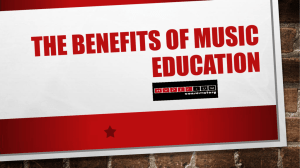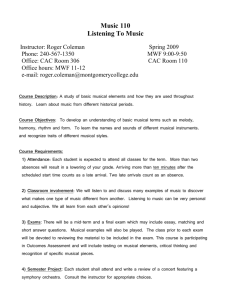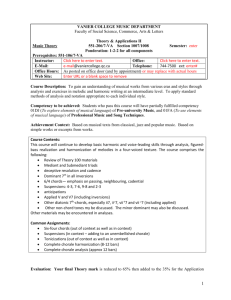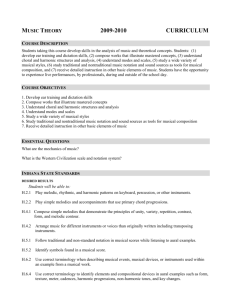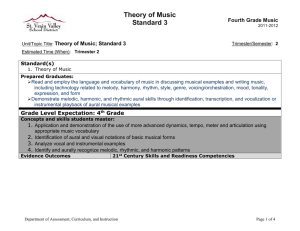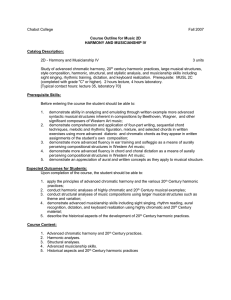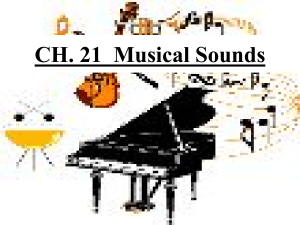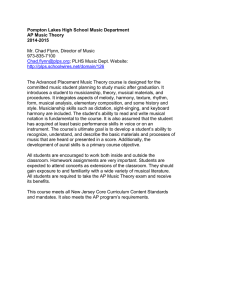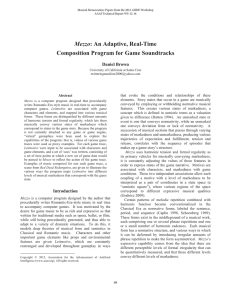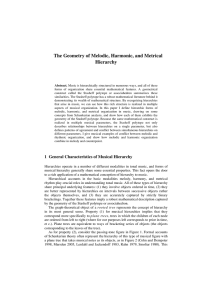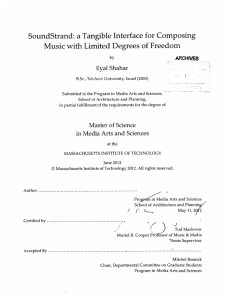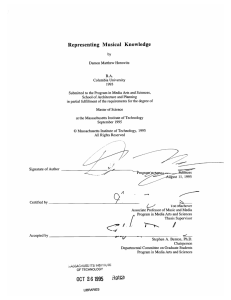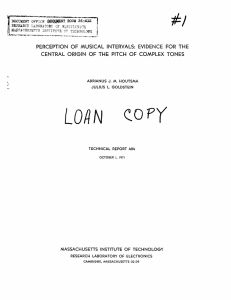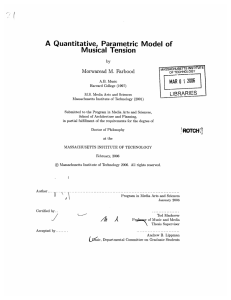Writing in Music - Thompson Writing Program
advertisement
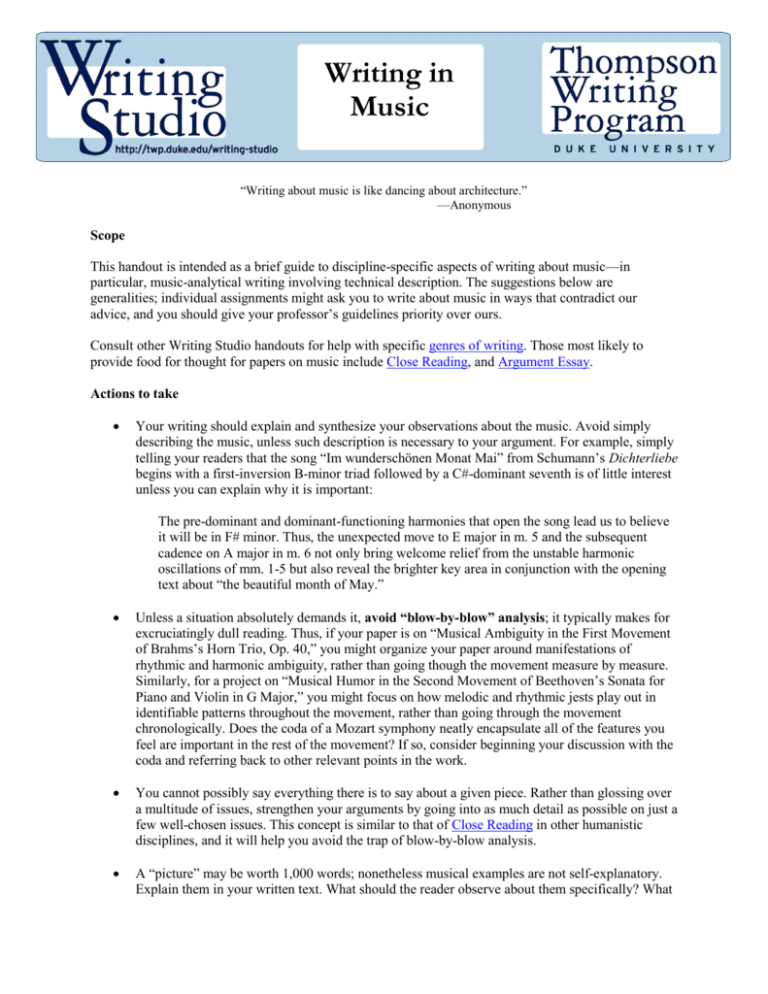
Writing in Music “Writing about music is like dancing about architecture.” —Anonymous Scope This handout is intended as a brief guide to discipline-specific aspects of writing about music—in particular, music-analytical writing involving technical description. The suggestions below are generalities; individual assignments might ask you to write about music in ways that contradict our advice, and you should give your professor’s guidelines priority over ours. Consult other Writing Studio handouts for help with specific genres of writing. Those most likely to provide food for thought for papers on music include Close Reading, and Argument Essay. Actions to take Your writing should explain and synthesize your observations about the music. Avoid simply describing the music, unless such description is necessary to your argument. For example, simply telling your readers that the song “Im wunderschönen Monat Mai” from Schumann’s Dichterliebe begins with a first-inversion B-minor triad followed by a C#-dominant seventh is of little interest unless you can explain why it is important: The pre-dominant and dominant-functioning harmonies that open the song lead us to believe it will be in F# minor. Thus, the unexpected move to E major in m. 5 and the subsequent cadence on A major in m. 6 not only bring welcome relief from the unstable harmonic oscillations of mm. 1-5 but also reveal the brighter key area in conjunction with the opening text about “the beautiful month of May.” Unless a situation absolutely demands it, avoid “blow-by-blow” analysis; it typically makes for excruciatingly dull reading. Thus, if your paper is on “Musical Ambiguity in the First Movement of Brahms’s Horn Trio, Op. 40,” you might organize your paper around manifestations of rhythmic and harmonic ambiguity, rather than going though the movement measure by measure. Similarly, for a project on “Musical Humor in the Second Movement of Beethoven’s Sonata for Piano and Violin in G Major,” you might focus on how melodic and rhythmic jests play out in identifiable patterns throughout the movement, rather than going through the movement chronologically. Does the coda of a Mozart symphony neatly encapsulate all of the features you feel are important in the rest of the movement? If so, consider beginning your discussion with the coda and referring back to other relevant points in the work. You cannot possibly say everything there is to say about a given piece. Rather than glossing over a multitude of issues, strengthen your arguments by going into as much detail as possible on just a few well-chosen issues. This concept is similar to that of Close Reading in other humanistic disciplines, and it will help you avoid the trap of blow-by-blow analysis. A “picture” may be worth 1,000 words; nonetheless musical examples are not self-explanatory. Explain them in your written text. What should the reader observe about them specifically? What Duke Writing Studio 2 point(s) in your argument do they illustrate or support? All musical examples should include a brief identifying caption and an example number referred to in the text (abbreviate “example” as “Ex.”). Assist your reader by identifying the source of musical examples as necessary (e.g. composer, composition, movement, measure numbers, etc.). Examples should include only relevant portions of the score. Do you need a full score, or will a piano reduction do? Do you need all 25 measures on the page of the score or just mm. 5-8? Do you need all of the notes in mm. 5-8, or will a melodic and/or harmonic reduction suffice (e.g. Schenkerian or other analytic-reductive notation)? Tables, charts, graphs, etc. can be useful for conveying a large amount of information in a concise form; like musical examples, they also require explanation in your written text. If the emphasis of your paper is analytical, use good judgment when providing historical background or other context for the compositions you discuss. Debussy may have won the Prix de Rome in 1884, but is that really relevant to your discussion of the Prélude á l’Après-midi d’un faune? On the other hand, you might want to mention Dame Ethel Smyth’s involvement in the suffrage movement as context for your paper on “Thwarted Expectations: Musical Subversion in The Boatswain’s Mate (1911),” and Antonin Dvorak’s visit to the United States in your project on the “New World” Symphony. Music often evokes strong emotional responses in listeners—though not all listeners respond to the same piece in the same way. For one person, a piece might sound “powerful,” for another “violent.” Support evaluative (interpretive) claims with intrinsic evidence from the music: POOR: The music becomes angrier in m. 112. BETTER: The accelerating pulsing of the strings and horns soon builds to a frenzy that violently overwhelms the oboe melody in m. 112. Include measure numbers when referring to specific points in a composition. Avoid referring to formal divisions without providing measure numbers, as parsings of form are often subject to debate. Abbreviate “measure” and “measures” as “m.” and “mm.” Scholarly research involves dialog with others, whether in person or through written responses to published work. All sources paraphrased or quoted directly must be cited. Citation style guidelines vary from journal to journal; refer to a journal or consult with your professor regarding format preferences. Recommended texts Bellman, Jonathan. A Short Guide to Writing about Music. New York: Longman, 2000. Part of the Longman Short Guide series, Bellman’s text offers detailed advice on writing about music and addresses a variety of common genres (e.g. biography, history, analysis, review, criticism, program notes). The author guides readers through the research process, including information on how to evaluate, work with, and cite music-specific sources. Duke Writing Studio 3 Holoman, D. Kern. Writing About Music: A Style Sheet from the Editors of 19th-Century Music. Berkeley: University of California Press, 1988. The well-respected publication 19th-Century Music is among the most beautifully edited academic journals in musicology. Holoman’s style guide tells you close to everything you’re likely to want to know about the mechanics of writing about music. Portions of this handout were originally developed by the author for use at the Music Department of the University of Kansas.






